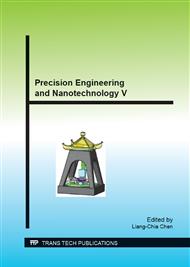p.123
p.129
p.134
p.140
p.149
p.155
p.161
p.167
p.172
Development of Fixing System for 2-Axis Micro Deep Drilling Assisted by Low Frequency Vibration
Abstract:
Micro deep drilling of hard materials is required to involve step feed in process that grows up machining time. To increase the step feed, a method with low frequency vibration (frequency ~190 Hz, amplitude ~10 μm) by oscillating of workpiece has been proposed. Previous study is focused on method of 1-axis drilling process assisted by low frequency vibration. Introducing the method with low frequency vibration to 2-axis drilling process on a curved surface is required to oscillate the workpiece in two dimensions. Purpose of our study is to design fixing system with the 2-dimansional low frequency vibration. Vibration source is needed to change for providing the 2-dimansional vibration. Fixing system for 2-dimensional vibration (FS2DV) consists of two vibration sources in horizontal and vertical directions with spring systems along it action. The 2-dimensional vibration is controlled by amplitude ratio of the vibrations from each source. As a result, we have succeeded low frequency vibration of the workpiece with assigned direction. The resulting vibration is verified (measuring of instantaneous horizontal and vertical displacements).
Info:
Periodical:
Pages:
149-154
Citation:
Online since:
August 2014
Authors:
Price:
Сopyright:
© 2015 Trans Tech Publications Ltd. All Rights Reserved
Share:
Citation:


